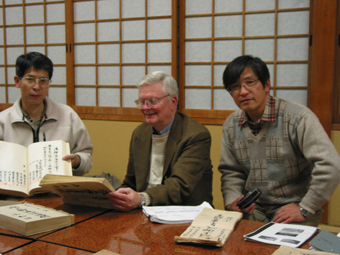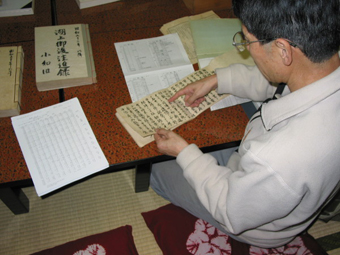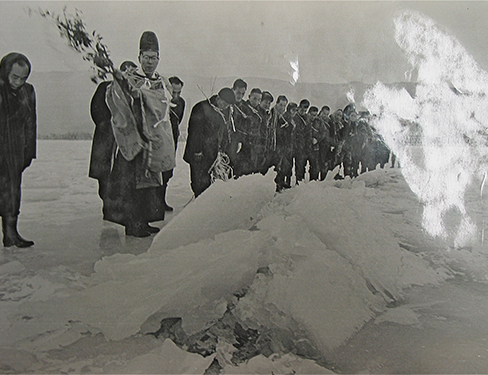Centuries of human observations of lake and river ice chronicle hastened climate warming

Professor Emeritus John Magnuson (center) during a trip to Japan where he was interested in using the recorded omiwatari dates to understand climate. Photo credit John Magnuson.

Kiyoshi Miyasaka pointing out original records, his data sheet summarizing the records is on the left side. Photo credit John Magnuson.
Most climate records predating the Industrial Revolution are the product of modern sampling used to reconstruct past conditions. However, Shinto priests have been recording the timing of the omiwatari on Lake Suwa, Japan for over 500 years (beginning 1443). The omiwatari is a buckling of lake ice that occurs just after freezing, and is said to be caused by a dragon god as he uses the ice to cross the lake and visit a goddess. The date of ice breakup on the river Torne, Finland has also been recorded for centuries (since 1693), in part due to the importance of the river for transportation and commerce. These culturally and economically motivated long-term records pre-date the Industrial Revolution (beginning ~1780), after which climate warming hastened, as evidenced by later ice formation (Suwa) and earlier ice breakup (Torne). Furthermore, Lake Suwa has failed to freeze with increasing frequency in recent years. These ancient records are direct human observations of the post-industrial acceleration of climate warming.

Shinto priests on Lake Suwa (2005). Photo credit: John Magnuson.
More coverage on this paper and topic:
- Story by Lisa Borre on the National Geographic Voices blog: Lake Suwa's Shinto Legend and the Oldest Lake Ice Record on Earth: What It Tells Us About Climate Change and Variability
Paper details:
Sapna Sharma, John J. Magnuson, Ryan D. Batt, Luke A. Winslow, Johanna Korhonen & Yasuyuki Aono. 2016.
Direct observations of ice seasonality reveal changes in climate over the past 320–570 years. Scientific Reports 6, Article number: 25061
See the paper DOI (abstract)
April 2017


